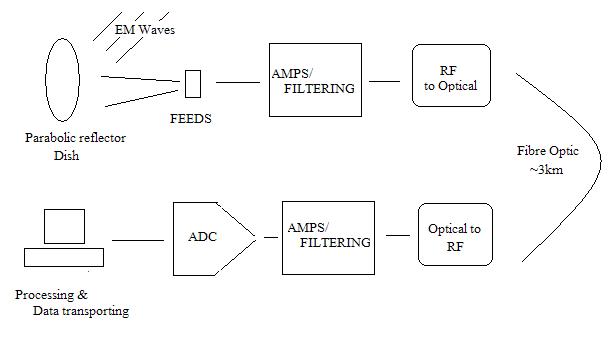home
Fibre Optic Calibrator for KAT
Background
The Karoo Array Telescope (KAT) is a radio telescope being build in the
Karoo, South Africa. You can read more about the KAT telescope at www.kat.ac.za.
Radio telescopes are designed to capture the Electro Magnetic waves of
Radio frequency wavelengths (??MHz to ??GHz) emitted by the cosmos. By
definition, it differs from optical, infrared, xray, etc.
telescopes in the frequency band which is being observed..
The high level view of the KAT telescope is shown in the figure below.

The parabolic reflector dish will focus the electromagnetic energy onto
the antenna feeds. Immediately after the feeds (and as close as
possible), there will be a Low Noise amplifier, bandpass
filtering, and further amplification and filtering. At the end of
this initial chain of signal conditioning, the RF signal will be
modulated onto an optical carrier, and transmitted across a fibre optic
cable, of about 3km length, to the control room. Inside the control
room the optical signal will be converted back to a RF signal, and then
filtered and amplified to a sufficient level to drive an Analogue to Digital
converter (ADC) for digitisation.
In the ideal scenario, we would like to have a scaled, but
exact replica of the input signal at our bandwidth of
interest, at the
input of the ADC. In reality however, we find that the amplification,
filtering and transport mechanism introduces amplitude, phase and
intermodulation degradation of this signal of interest. This
degradation should be minimised, firstly by good hardware design, and
subsequently by software calibration.
Note that this information signal might contain undesirable RF sources,
such as man-made RF interferences, etc which have already
corrupted the astrological signal before it was captured by the dish.
The point is just that ideally the means of "capturing", which is
our amplifying-optical chain described above, should not add any distortion / degradation to our signal of interest.
My Thesis
My thesis focusses on the fibre optic links. And more specifically, how
the phase of the optical signal changes over long time (more than a
hour), temperature and aging. Also the problem of quantifying the
amount of phase change, and possibly how to correct for
this change in phase.
my final-year undergraduate thesis